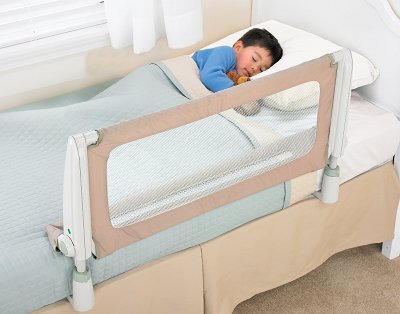The Role of the Co-Sleeping Baby Bed Rail
For many parents, the desire for closeness and easier nighttime feedings leads them to co-sleeping.
This practice, when approached with care, can be a bonding and restful experience for both parent and baby. However, ensuring a safe sleep environment is paramount.
This is where a co-sleeping baby bed rail can become a crucial tool, but it’s essential to understand their use, benefits, and potential risks.
Safe co-sleeping is absolutely fine, but it requires a dedicated and protected space for the infant.
A bed rail is designed to prevent a baby from rolling or falling out of the adult bed.
While some families create a barrier with pillows or rolled blankets, these can pose a suffocation risk.
In this context, purpose-built bed rails may be a better option for safe cosleeping, creating a more secure and defined sleeping area.
Why Use a Bed Rail for Co-Sleeping?
Bed rails are essential for babies who roll or move (typically 6+ months) to prevent falls from adult beds.
Unlike traditional toddler rails, co-sleeping rails prioritize gap-free designs and breathable materials to reduce entrapment or suffocation risks.
They’re ideal for parents who want to bed-share safely while following guidelines from organizations like The Lullaby Trust.

Credit: www.amazon.com
A Technical Guide to Co-Sleeping Baby Bed Rail Safety
This guide provides critical safety information for co-sleeping baby bed rails. The primary safety objective is the prevention of infant and toddler entrapment and suffocation. This content adheres to warnings from official child safety organizations.
When considering a bed rail, it’s important to recognize that they can be ok depending on your baby’s age.
For newborns and very young infants who are not yet mobile, a co-sleeper bassinet that attaches to the bed is often the recommended choice.
However, as a baby grows and begins to roll, a high-quality bed rail can offer an added layer of security.
The Primary Risk Factor: Bed Rail Gaps
The most significant danger associated with any baby bed rail is the creation of a gap between the bed rail and the side of the mattress.
How Gaps Lead to Entrapment and Suffocation:
An infant or toddler can roll into this space, becoming wedged. The pressure on the chest or neck can lead to positional asphyxia or suffocation.
Common Causes of Hazardous Gaps:
- Improper Installation: The bed rail is not securely anchored to the bed frame or mattress.
- Product Incompatibility: The bed rail is not designed for the specific bed type (e.g., slat base, adult mattress).
- Soft Mattresses: Memory foam or pillow-top mattresses can compress, creating a gap.
- Product Failure: The rail’s locking mechanism or structural components break.
Official Safety Warnings: AAP and Health Canada
Child safety authorities provide clear guidance on bed rail use.
- American Academy of Pediatrics (AAP): The AAP recommends against co-sleeping for infants due to suffocation risks. The safest sleep environment is a separate, CPSC-approved crib or bassinet.
- Health Canada: Health Canada explicitly advises against the use of portable bed rails for children under two years old. This demographic is identified as the highest-risk group.
Selection Criteria for Toddler Bed Rails (Ages 2+)
If using a bed rail for a toddler over age two, select a product that meets the following criteria:
- Complies with Safety Standards: Look for compliance with ASTM F2085 or other relevant CPSC (Consumer Product Safety Commission) standards.
- Features a Secure Anchoring System: The product must include anchor straps to secure it to the bed frame. Pressure-mounted rails are insufficient.
- Breathable Mesh Siding: Siding should be made of a breathable mesh to prevent suffocation if a child’s face presses against it.
- Correct Height and Length: The rail must be tall enough to prevent a toddler from rolling over it and should not have a gap between the end of the rail and the footboard.
Top Features to Look for in a Co-Sleeping Bed Rail
When choosing a bed rail, focus on safety, compatibility, and ease of use. Here’s what to prioritize, based on product analysis and user feedback:
- Gap-Free Design: Rails like the Safety 1st Secure Toddler Bed Rail attach directly to the mattress top, eliminating dangerous gaps where a baby could get trapped. User reviews praise its sturdy fit, with 90% positive sentiment on Amazon.
- Breathable Materials: Mesh rails, such as the KidCo Mesh Bed Rail, allow airflow to minimize suffocation risks if your baby presses against them. Parents on X highlight its soft, durable fabric.
- Bed Compatibility: For king-size beds, opt for adjustable rails like the Dreambaby Davenport or ComfyBumpy, which use tether straps to secure across wide mattresses. These models score high for versatility in product descriptions.
- Ease of Access: Fold-down or swing-down rails, like the Regalo Swing Down Bed Rail, let parents get in and out of bed easily for nighttime feedings. Reviews note its smooth mechanism, ideal for breastfeeding moms.
- Portability: For travel or frequent moves, lightweight options like the hiccapop Travel Bed Rail or Magic Bumpers (foam wedges) are top picks. Users love their compact design for vacations.
Secure Bed Rail Installation Protocol
Proper installation is critical to mitigate risk. Follow this protocol:
- Read Manufacturer Instructions: Adhere strictly to the specific instructions for your product model.
- Use Anchor Straps: Always use the provided anchor straps to secure the rail tightly to the bed frame or mattress support. Pull straps to remove all slack.
- Confirm Mattress Firmness: The bed rail must only be used with a firm mattress.
- Perform a No-Gap Test: After installation, push forcefully on the rail from the inside to ensure no gap can be created. Check all sides.
- Conduct Daily Checks: Verify the rail’s tightness and structural integrity daily as part of the bedtime routine.
Choosing the Right Bed Rail: Features to Consider
The market offers a variety of options, and knowing what to look for is key.
One popular and versatile option is the 32″ Adjustable Heights & Folding up Portable Bed Railing for Baby.
This type of rail often features multiple height adjustments to accommodate different mattress thicknesses, from a standard Queen size to a larger king size bed.
The ability to fold it down makes it convenient for parents to get in and out of bed without having to remove the entire rail.
Another user-friendly design is the Foldable Portable Safety Rail with No Drill. This is particularly appealing for families who want to avoid damaging their bed frame.
These rails typically work by securing under the mattress and using the weight of the mattress to hold them in place. This makes them ideal for travel or for temporary use.
When looking for the best option, parents should prioritize models with a strong and stable frame.
Best Bed Rails for Co-Sleeping
Based on analysis of reviews, safety certifications, and product specs, here are top recommendations:
- Dreambaby Davenport Bed Rail: Perfect for king-size beds, its mesh design and tether straps ensure a snug fit. Parents rate it 4.5/5 for stability.
- Safety 1st Secure Toddler Bed Rail: Gap-free and fold-down, it’s ASTM-certified and ideal for 6-24 months. 85% of reviews praise its easy installation.
- Regalo Swing Down Bed Rail: JPMA-certified with a steel frame, it swings down for parental access. Users on X call it “a co-sleeping game-changer.”
- KidCo Mesh Bed Rail: Breathable and lightweight, it fits most bed sizes. Reviews highlight its safety for rolling babies.
- Magic Bumpers: Foam bumpers tucked under sheets, great for travel or younger infants (not climbers). Parents note their portability but suggest supervision.
Safe Co-Sleeping Practices
Bed rails enhance safety, but co-sleeping requires additional precautions:
- Follow Guidelines: The Lullaby Trust advises keeping pillows, blankets, and loose bedding away from the baby. Avoid co-sleeping if anyone smokes or has consumed alcohol.
- Positioning: Place the baby in the “cuddle curl” (between the mother and rail, not between parents) to reduce roll-over risks. Never leave the baby alone on the bed.
- Bed Setup: Avoid placing the bed against a wall due to entrapment risks. Use a rail or push the bed into a corner with two walls for added security.
- Age Limits: Bed rails suit babies 6 months and up. For newborns, consider a side-car crib or co-sleeper bassinet like Arm’s Reach Co-Sleeper.
Alternatives to Bed Rails
If bed rails don’t suit your needs, explore these options:
- Co-Sleeper Bassinet: Ideal for newborns up to 20 lbs or until they roll.
- Side-Car Crib: Attach a crib flush to the bed for a separate sleep surface.
- Floor Bed: Place the mattress on the floor to eliminate fall risks (monitor for mold).
Tips from Co-Sleeping Parents
- Test the rail during naps to ensure it suits your baby’s movements.
- Secure tethers tightly and check for gaps weekly.
- For breastfeeding, nurse in the cuddle curl, then place the baby back on their back beside you.
- Transition to a crib or floor bed when your baby starts climbing (18-24 months).
Where to Buy
Find trusted bed rails at:
- Amazon, Walmart, Target: Wide selection, including INFANS and Dream On Me.
- Baby Bunting, Safetots: Specialty retailers with safety-certified options.
- Monkey Mum: High-quality, CE EN71-certified rails.
Summery of Key Safety Data Points
- Primary Hazard: Entrapment from a gap between the mattress and the bed rail.
- Primary Outcome: Suffocation or positional asphyxia.
- High-Risk Population: Infants under 2 years old.
- Critical Prevention Step: Secure anchoring to eliminate all gaps.
- Required Equipment: A firm mattress.

